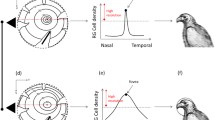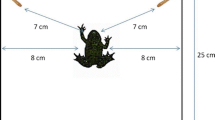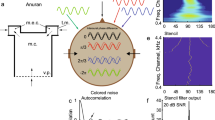Summary
We have investigated the role that retinal elevation plays in a frog's (Rana pipiens) estimate of prey distance. We dissociated retinal elevation from other depth cues by artificially increasing the height of the frogs' eyes above the ground. Frogs then snapped short of their prey in their ventral visual field as if their estimate of distance were determined primarily by the retinal elevation of the image of the prey. The data suggest that the frog assumes its eyes to be about 3 cm above the ground. Other cues modify depth judgements when targets are close to this assumed groundplane.
Similar content being viewed by others
References
Beebee TJC (1985) Frogs and toads. Whittet, London
Collett TS (1977) Stereopsis in toads. Nature 267:349–351
Collett TS, Harkness LIK (1982) Distance vision in animals. In: Ingle DJ, Goodale MA, Mansfield RJW. Analysis of visual behaviour. MIT Press, Cambridge, pp 111–176
Cooper ML, Pettigrew JD (1979) A neurophysiological determination of the vertical horopter in the cat and owl. J Comp Neuroll 184:1–26
Douglas RH, Collett TS, Wagner H-J (1986) Accommodation in anuran Amphibia and its role in depth vision. J Comp Physiol A 158:133–143
Fitzke FW, Hayes BP, Hodos W, Holden AL, Low JC (1985) Refractive sectors in the visual field of the pigeon eye. J Physiol 369:33–44
Grobstein P, Reyes A, Zwanziger L, Kostyk SK (1985) Prey orienting in frog: accounting for variations in output with stimulus distance. J Comp Physiol A 156:775–785
Jordan M, Luthardt G, Meyr-Naujoks C, Roth G (1980) The role of eye accommodation in the depth perception of common toads. Z Naturforsch 35c:851–852
Kilby JD (1945) A biological analysis of the food and feeding habits of two frogs,Hyla cinerea cinerea andRana pipiens sphenocephala. Quart J Florida Acad Sci 8:71–104
Matthis U, Schaeffel F, Howland HC (1987) Studies of visual optics in toads. Invest Ophthalmol Visual Sci 28 [Suppl3]:217
Podufal G (1971) Zur Entfernungsmessung und Größenbeurteilung durch die Erdkröte (Bufo bufo L.). Thesis, Göttingen
Schwind R (1978) Visual system ofNotonecta glauca. J Comp Physiol 123:315–328
Zeil J, Nalbach G, Nalbach HO (1986) Eyes, eye stalks and the visual world of semi-terrestrial crabs. J Comp Physiol A 159:801–811
Author information
Authors and Affiliations
Rights and permissions
About this article
Cite this article
Collett, T.S., Udin, S.B. Frogs use retinal elevation as a cue to distance. J. Comp. Physiol. 163, 677–683 (1988). https://doi.org/10.1007/BF00603852
Accepted:
Issue Date:
DOI: https://doi.org/10.1007/BF00603852




